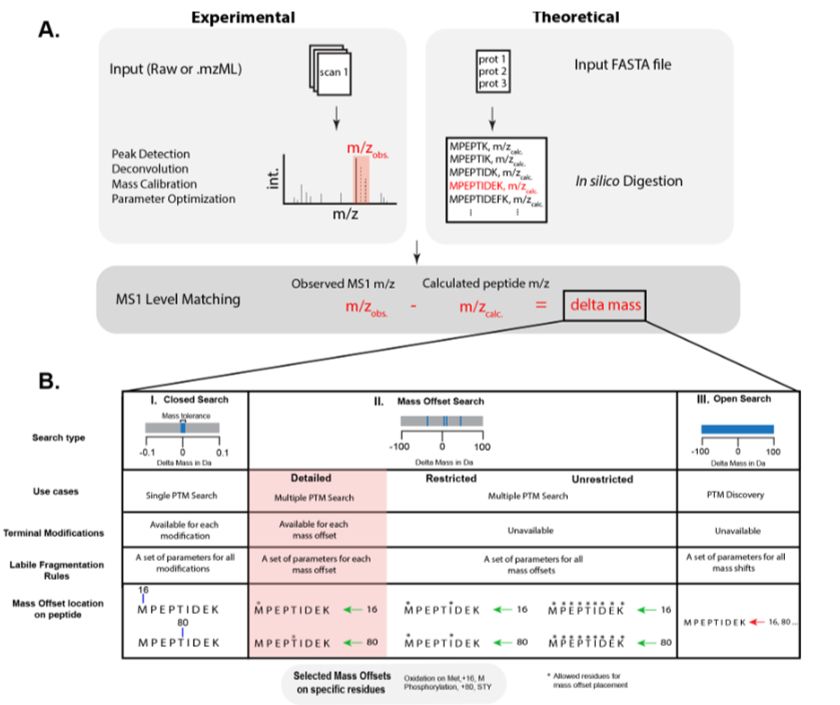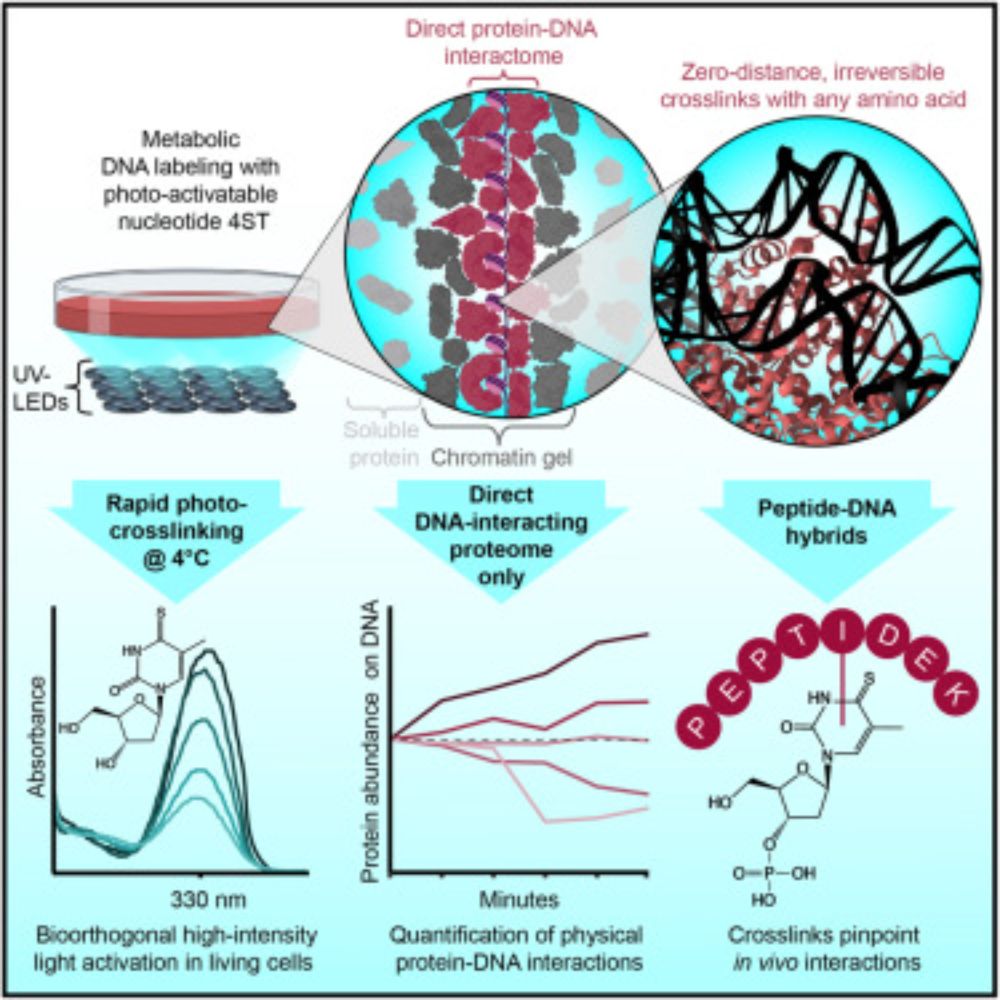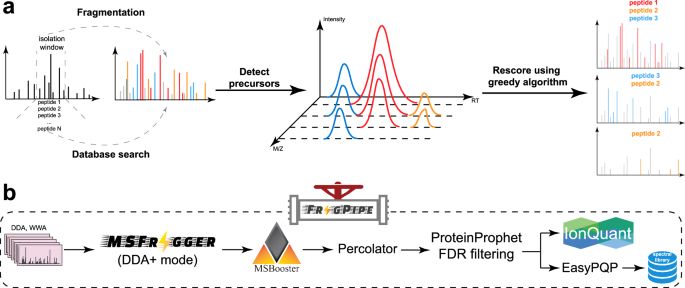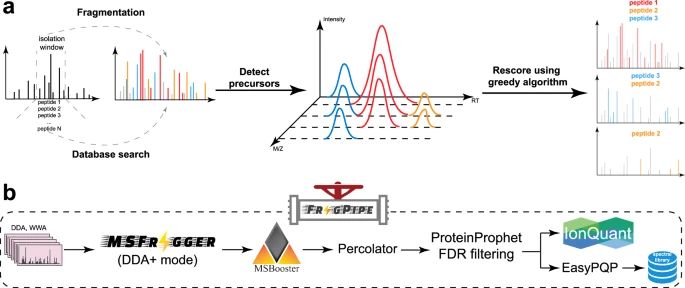We established a completely unbiased workflow to study electrophile reactivity and selectivity in the entire proteome using isoDTB-ABPP (onlinelibrary.wiley.com/doi/full/10....) and analysis in #MSFragger (www.nature.com/articles/nme...) and applied it to characterize >50 electrophiles. (2/7)

Isotopically Labeled Desthiobiotin Azide (isoDTB) Tags Enable Global Profiling of the Bacterial Cysteinome
On target: Isotopically labeled desthiobiotin azide (isoDTB) tags were synthesized in a straightforward manner and allowed residue-specific profiling of the cysteinome in S. aureus. In this way, 268 ...
onlinelibrary.wiley.com
October 30, 2025 at 10:27 AM
We established a completely unbiased workflow to study electrophile reactivity and selectivity in the entire proteome using isoDTB-ABPP (onlinelibrary.wiley.com/doi/full/10....) and analysis in #MSFragger (www.nature.com/articles/nme...) and applied it to characterize >50 electrophiles. (2/7)
Alright, help from my "wider" mass tolerance peeps ( @pwilmarth.bsky.social @ypriverol.bsky.social @michaellazear.bsky.social): I have confirmed what you all said that 1.25 Da MS1 and 20 ppm MS2 is a winning DDA combination. But I see in MSFragger I can do an upper and lower. Do +- 1.25 Da on MS1?
September 3, 2025 at 7:31 PM
Alright, help from my "wider" mass tolerance peeps ( @pwilmarth.bsky.social @ypriverol.bsky.social @michaellazear.bsky.social): I have confirmed what you all said that 1.25 Da MS1 and 20 ppm MS2 is a winning DDA combination. But I see in MSFragger I can do an upper and lower. Do +- 1.25 Da on MS1?
#MSFragger Open Search has been around for a while now and used by mass spec folks to screen for chemical artifacts and adducts, e.g. in chemoproteomics data. Happy to see it got 'discovered' by a broader community who are now reporting all sort of cool biological PTMs www.nature.com/articles/s41...

Nucleoside diphosphate kinase A (NME1) catalyses its own oligophosphorylation - Nature Chemistry
Our understanding of how post-translational modification—protein phosphorylation—impacts the complexity of eukaryotic signalling pathways is continuously expanding. Now, protein oligophosphorylation h...
www.nature.com
August 20, 2025 at 3:55 PM
#MSFragger Open Search has been around for a while now and used by mass spec folks to screen for chemical artifacts and adducts, e.g. in chemoproteomics data. Happy to see it got 'discovered' by a broader community who are now reporting all sort of cool biological PTMs www.nature.com/articles/s41...
A New Detailed Mass Offset Search in MSFragger for Improved Interpretation of Complex PTMs www.biorxiv.org/cont...
---
#proteomics #prot-preprint
---
#proteomics #prot-preprint

August 2, 2025 at 8:20 AM
A New Detailed Mass Offset Search in MSFragger for Improved Interpretation of Complex PTMs www.biorxiv.org/cont...
---
#proteomics #prot-preprint
---
#proteomics #prot-preprint
Conventional proteomics searches struggle with many modifications and fully open searches may be difficult to interpret. We introduce a "detailed" mass offset search in #MSFragger boosting interpretability and localization especially in complex cases (e.g. FPOP data): www.biorxiv.org/content/10.1...

August 1, 2025 at 9:33 PM
Conventional proteomics searches struggle with many modifications and fully open searches may be difficult to interpret. We introduce a "detailed" mass offset search in #MSFragger boosting interpretability and localization especially in complex cases (e.g. FPOP data): www.biorxiv.org/content/10.1...
A New Detailed Mass Offset Search in MSFragger for Improved Interpretation of Complex PTMs https://www.biorxiv.org/content/10.1101/2025.07.28.667198v1
August 1, 2025 at 3:48 AM
A New Detailed Mass Offset Search in MSFragger for Improved Interpretation of Complex PTMs https://www.biorxiv.org/content/10.1101/2025.07.28.667198v1
A New Detailed Mass Offset Search in MSFragger for Improved Interpretation of Complex PTMs https://www.biorxiv.org/content/10.1101/2025.07.28.667198v1
August 1, 2025 at 3:48 AM
A New Detailed Mass Offset Search in MSFragger for Improved Interpretation of Complex PTMs https://www.biorxiv.org/content/10.1101/2025.07.28.667198v1
Comet-FI, with inspiration from MSFragger and Sage, enables some fun applications for open modification searching (a not-quite-as-fast homage to @nesvilab.bsky.social & @fcyucn.bsky.social's work), and immunopeptidomics.
Better yet, Comet-FI can be used wherever Comet is used! uwpr.github.io/Comet/
Better yet, Comet-FI can be used wherever Comet is used! uwpr.github.io/Comet/

June 17, 2025 at 8:57 PM
Comet-FI, with inspiration from MSFragger and Sage, enables some fun applications for open modification searching (a not-quite-as-fast homage to @nesvilab.bsky.social & @fcyucn.bsky.social's work), and immunopeptidomics.
Better yet, Comet-FI can be used wherever Comet is used! uwpr.github.io/Comet/
Better yet, Comet-FI can be used wherever Comet is used! uwpr.github.io/Comet/
At today's #ASMS2025 Glycopeptides & Glycoproteins session:
N-glycoproteomics in cancer; enriching glycopeptides, use of pGlyco3+MSFragger+pGlycompare to evaluate turnover; O-GalNAcylation in diabetes; whether Tyr can be O-GlcNAcylated; metabolic labelling to identify O-GlcNAc-peptides.
N-glycoproteomics in cancer; enriching glycopeptides, use of pGlyco3+MSFragger+pGlycompare to evaluate turnover; O-GalNAcylation in diabetes; whether Tyr can be O-GlcNAcylated; metabolic labelling to identify O-GlcNAc-peptides.

June 3, 2025 at 9:43 PM
At today's #ASMS2025 Glycopeptides & Glycoproteins session:
N-glycoproteomics in cancer; enriching glycopeptides, use of pGlyco3+MSFragger+pGlycompare to evaluate turnover; O-GalNAcylation in diabetes; whether Tyr can be O-GlcNAcylated; metabolic labelling to identify O-GlcNAc-peptides.
N-glycoproteomics in cancer; enriching glycopeptides, use of pGlyco3+MSFragger+pGlycompare to evaluate turnover; O-GalNAcylation in diabetes; whether Tyr can be O-GlcNAcylated; metabolic labelling to identify O-GlcNAc-peptides.
The power of #MSFragger open search! “we applied the mass-tolerant search engine MSfragger and found that phosphorylation as well as ubiquitination were well preserved after XDNAX. To our great interest, we found an additional modification of 321 Da occurring only in the irradiated SILAC channel”
🚨Our new paper is online🚨
We use zero-distance⚡photo-crosslinking⚡to reveal direct protein-DNA interactions in living cells, enabling quantitative analysis of the DNA-interacting proteome on a timescale of minutes. #DNA #Chromatin #Proteomics
www.cell.com/cell/fulltex...
We use zero-distance⚡photo-crosslinking⚡to reveal direct protein-DNA interactions in living cells, enabling quantitative analysis of the DNA-interacting proteome on a timescale of minutes. #DNA #Chromatin #Proteomics
www.cell.com/cell/fulltex...

The human proteome with direct physical access to DNA
Zero-distance photo-crosslinking reveals direct protein-DNA interactions in living
cells, enabling quantitative analysis of the DNA-interacting proteome on a timescale
of minutes with single-amino-aci...
www.cell.com
May 23, 2025 at 12:41 PM
The power of #MSFragger open search! “we applied the mass-tolerant search engine MSfragger and found that phosphorylation as well as ubiquitination were well preserved after XDNAX. To our great interest, we found an additional modification of 321 Da occurring only in the irradiated SILAC channel”
In a 2 year period, we have had three major DIA software platforms (one open source) establish companies.
The newest, Fragmatics, is now licensing MSfragger instead of the University of Michigan.
www.fragmatics.com
The newest, Fragmatics, is now licensing MSfragger instead of the University of Michigan.
www.fragmatics.com

May 8, 2025 at 8:54 PM
In a 2 year period, we have had three major DIA software platforms (one open source) establish companies.
The newest, Fragmatics, is now licensing MSfragger instead of the University of Michigan.
www.fragmatics.com
The newest, Fragmatics, is now licensing MSfragger instead of the University of Michigan.
www.fragmatics.com
Exciting news: We have released #FragPipe 23, and it's one of our biggest updates ever. Windows installer, support for TMT on Astral and timsTOF, TMT35, PTM site reports for DIA, improved Astral data handling in #MSFragger, improved diaTracer for diaPASEF data, better Skyline integration, and more!

May 5, 2025 at 4:06 AM
Exciting news: We have released #FragPipe 23, and it's one of our biggest updates ever. Windows installer, support for TMT on Astral and timsTOF, TMT35, PTM site reports for DIA, improved Astral data handling in #MSFragger, improved diaTracer for diaPASEF data, better Skyline integration, and more!
📈 Fig 2: Challenging data? CHIMERYS shines!
Extract more IDs from any DDA data — good for revisiting legacy data, even low-res.
→ 4x more throughput without loss in IDs
→ 2x more IDs at the same throughput
→ Cloud-based for speed & scalability
Unveil secrets older data hold!
3/7
Extract more IDs from any DDA data — good for revisiting legacy data, even low-res.
→ 4x more throughput without loss in IDs
→ 2x more IDs at the same throughput
→ Cloud-based for speed & scalability
Unveil secrets older data hold!
3/7

April 22, 2025 at 1:20 PM
📈 Fig 2: Challenging data? CHIMERYS shines!
Extract more IDs from any DDA data — good for revisiting legacy data, even low-res.
→ 4x more throughput without loss in IDs
→ 2x more IDs at the same throughput
→ Cloud-based for speed & scalability
Unveil secrets older data hold!
3/7
Extract more IDs from any DDA data — good for revisiting legacy data, even low-res.
→ 4x more throughput without loss in IDs
→ 2x more IDs at the same throughput
→ Cloud-based for speed & scalability
Unveil secrets older data hold!
3/7
MSFragger-DDA+ boosts peptide ID sensitivity by using full isolation window search. It effectively tackles chimeric spectra from co-fragmented peptides. PMID:40199897, Nat Commun 2025, @NatureComms https://doi.org/10.1038/s41467-025-58728-z #Medsky #Pharmsky #RNA #ASHG #ESHG 🧪

MSFragger-DDA+ enhances peptide identification sensitivity with full isolation window search | Nature Communications
Liquid chromatography-mass spectrometry based proteomics, particularly in the bottom-up approach, relies on the digestion of proteins into peptides for subsequent separation and analysis. The most prevalent method for identifying peptides from data-dependent acquisition mass spectrometry data is database search. Traditional tools typically focus on identifying a single peptide per tandem mass spectrum, often neglecting the frequent occurrence of peptide co-fragmentations leading to chimeric spectra. Here, we introduce MSFragger-DDA+, a database search algorithm that enhances peptide identification by detecting co-fragmented peptides with high sensitivity and speed. Utilizing MSFragger’s fragment ion indexing algorithm, MSFragger-DDA+ performs a comprehensive search within the full isolation window for each tandem mass spectrum, followed by robust feature detection, filtering, and rescoring procedures to refine search results. Evaluation against established tools across diverse datasets
doi.org
April 20, 2025 at 11:10 AM
MSFragger-DDA+ is a database search tool that enhances peptide identification by searching the full isolation window. #Proteomics @fcyucn.bsky.social @nesvilab.bsky.social
www.nature.com/articles/s41...
www.nature.com/articles/s41...

MSFragger-DDA+ enhances peptide identification sensitivity with full isolation window search - Nature Communications
Proteomics often misses co-fragmented peptides in DDA data. Here, the authors introduce MSFragger-DDA+, a database search tool that enhances peptide identification by searching the full isolation wind...
www.nature.com
April 15, 2025 at 4:39 PM
MSFragger-DDA+ is a database search tool that enhances peptide identification by searching the full isolation window. #Proteomics @fcyucn.bsky.social @nesvilab.bsky.social
www.nature.com/articles/s41...
www.nature.com/articles/s41...
MSFragger-DDA+ enhances peptide identification sensitivity with full isolation window search #NatCommun www.nature.com/articles/s41...
MSFragger-DDA+ enhances peptide identification sensitivity with full isolation window search - Nature Communications
Proteomics often misses co-fragmented peptides in DDA data. Here, the authors introduce MSFragger-DDA+, a database search tool that enhances peptide identification by searching the full isolation wind...
www.nature.com
April 9, 2025 at 5:59 PM
MSFragger-DDA+ enhances peptide identification sensitivity with full isolation window search #NatCommun www.nature.com/articles/s41...
DDA is still great for many applications, and #MSFragger-DDA+ improves peptide identification sensitivity via full isolation window search. Huge boosts in IDs, including Astral DDA! Fully integrated in #FragPipe, simply annotate your DDA files as DDA+ and RUN. www.nature.com/articles/s41...

MSFragger-DDA+ enhances peptide identification sensitivity with full isolation window search - Nature Communications
Proteomics often misses co-fragmented peptides in DDA data. Here, the authors introduce MSFragger-DDA+, a database search tool that enhances peptide identification by searching the full isolation wind...
www.nature.com
April 9, 2025 at 1:27 PM
DDA is still great for many applications, and #MSFragger-DDA+ improves peptide identification sensitivity via full isolation window search. Huge boosts in IDs, including Astral DDA! Fully integrated in #FragPipe, simply annotate your DDA files as DDA+ and RUN. www.nature.com/articles/s41...
MSFragger-DDA+ enhances peptide identification sensitivity with full isolation window search www.nature.com/artic...
---
#proteomics #prot-paper
---
#proteomics #prot-paper

April 8, 2025 at 6:00 PM
MSFragger-DDA+ enhances peptide identification sensitivity with full isolation window search www.nature.com/artic...
---
#proteomics #prot-paper
---
#proteomics #prot-paper
“We demonstrate that the new Tide architecture is around 2-7 times faster than the previous version and is now comparable to MSFragger and Sage in speed while requiring much less memory. Tide is open source…”
Looks to be the most lightweight proteomics search engine available.
Looks to be the most lightweight proteomics search engine available.
Fast and memory efficient searching of large-scale mass spectrometry data using Tide www.biorxiv.org/cont...
---
#proteomics #prot-preprint
---
#proteomics #prot-preprint

April 7, 2025 at 7:49 PM
“We demonstrate that the new Tide architecture is around 2-7 times faster than the previous version and is now comparable to MSFragger and Sage in speed while requiring much less memory. Tide is open source…”
Looks to be the most lightweight proteomics search engine available.
Looks to be the most lightweight proteomics search engine available.
Please use our GitHub sites for such technical questions. And please consider switching to FragPipe as I am not sure how long the MSFragger PD node will be maintained given how well FragPipe is working.
April 7, 2025 at 12:08 PM
Please use our GitHub sites for such technical questions. And please consider switching to FragPipe as I am not sure how long the MSFragger PD node will be maintained given how well FragPipe is working.
Extremely niche troubleshooting request, but is anyone familiar with implementing MSFragger in Proteome Discoverer? A few of us keep seeing these error messages, but none of us are tech savvy enough to decode it. Every time we "solve" it, it happens again.. #proteomics #teammassspec

April 5, 2025 at 8:50 PM
Extremely niche troubleshooting request, but is anyone familiar with implementing MSFragger in Proteome Discoverer? A few of us keep seeing these error messages, but none of us are tech savvy enough to decode it. Every time we "solve" it, it happens again.. #proteomics #teammassspec
Yes this was when I was rotating in the lab learning how to use MSFragger!
After a Google search, it looks like
@proteomicsnews.bsky.social presented a poster at ASMS?
After a Google search, it looks like
@proteomicsnews.bsky.social presented a poster at ASMS?
March 25, 2025 at 1:35 PM
Yes this was when I was rotating in the lab learning how to use MSFragger!
After a Google search, it looks like
@proteomicsnews.bsky.social presented a poster at ASMS?
After a Google search, it looks like
@proteomicsnews.bsky.social presented a poster at ASMS?
This is why everyone should run open searches and semi-tryptic searches on their samples, at least once in a while (and may I suggest a tool for that, #MSFragger in #FragPipe). I do it all the time myself as a “hobby”, using already published data, and find so many weird and interesting things.
March 6, 2025 at 8:40 AM
This is why everyone should run open searches and semi-tryptic searches on their samples, at least once in a while (and may I suggest a tool for that, #MSFragger in #FragPipe). I do it all the time myself as a “hobby”, using already published data, and find so many weird and interesting things.
In Panorama Public we require an annotated Skyline doc. It's easy to generate a Skyline document from DIA-NN, EncyclopeDIA, MSFragger-DIA, DIA-Umpire, or OpenSWATH output. Several of the tools can be run directly within Skyline.
January 9, 2025 at 2:55 PM
In Panorama Public we require an annotated Skyline doc. It's easy to generate a Skyline document from DIA-NN, EncyclopeDIA, MSFragger-DIA, DIA-Umpire, or OpenSWATH output. Several of the tools can be run directly within Skyline.
Got chatgpt to have a go. It looks crap but to be fair this is what it would look like if dell attempted to actually make a prodigy firestarter laptop. Also it would be $5000 dollars and have a mid graphics card that would be underpowered due to bad thermals. Fine for maxquant and msfragger.

January 6, 2025 at 9:32 PM
Got chatgpt to have a go. It looks crap but to be fair this is what it would look like if dell attempted to actually make a prodigy firestarter laptop. Also it would be $5000 dollars and have a mid graphics card that would be underpowered due to bad thermals. Fine for maxquant and msfragger.

